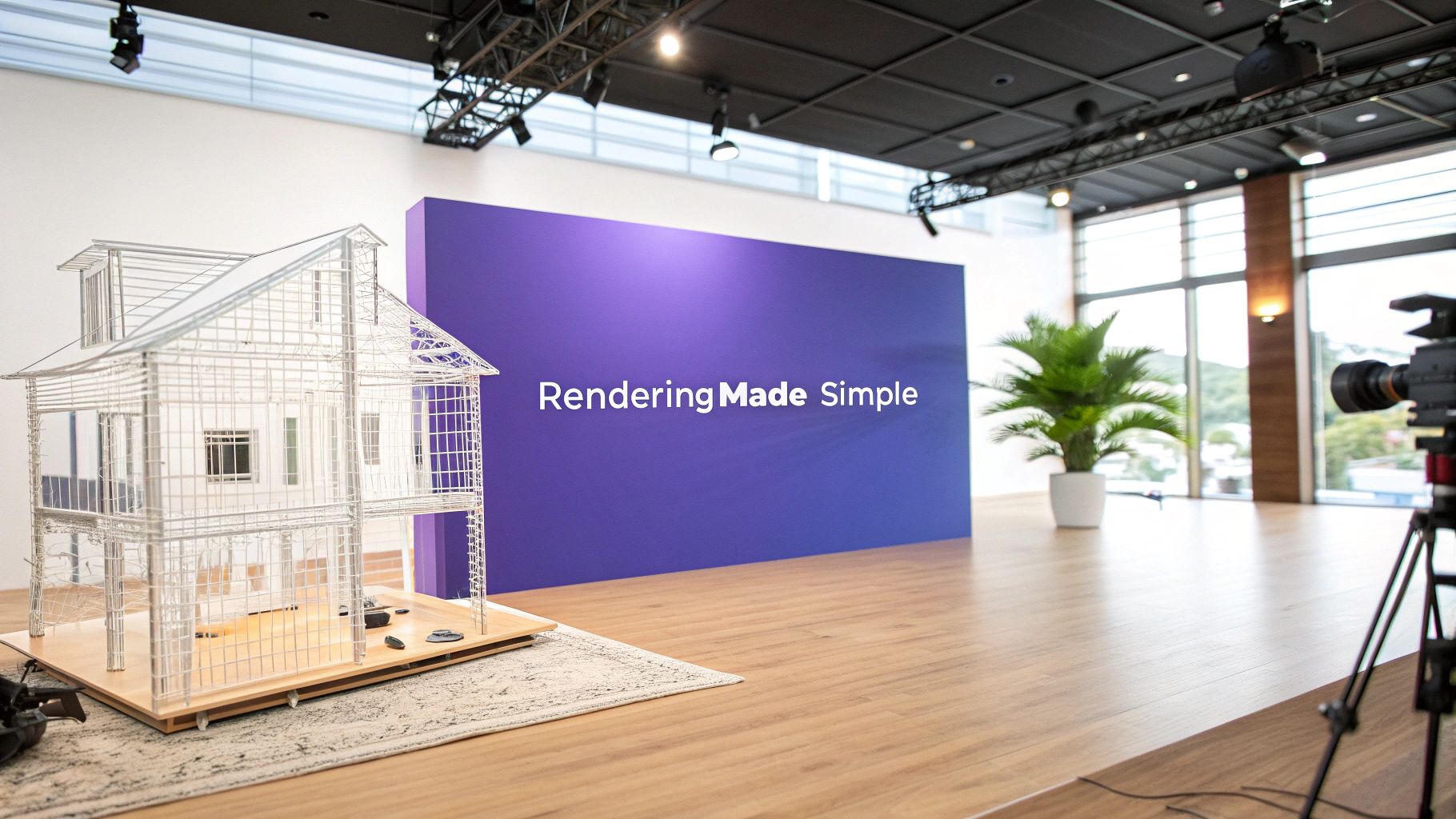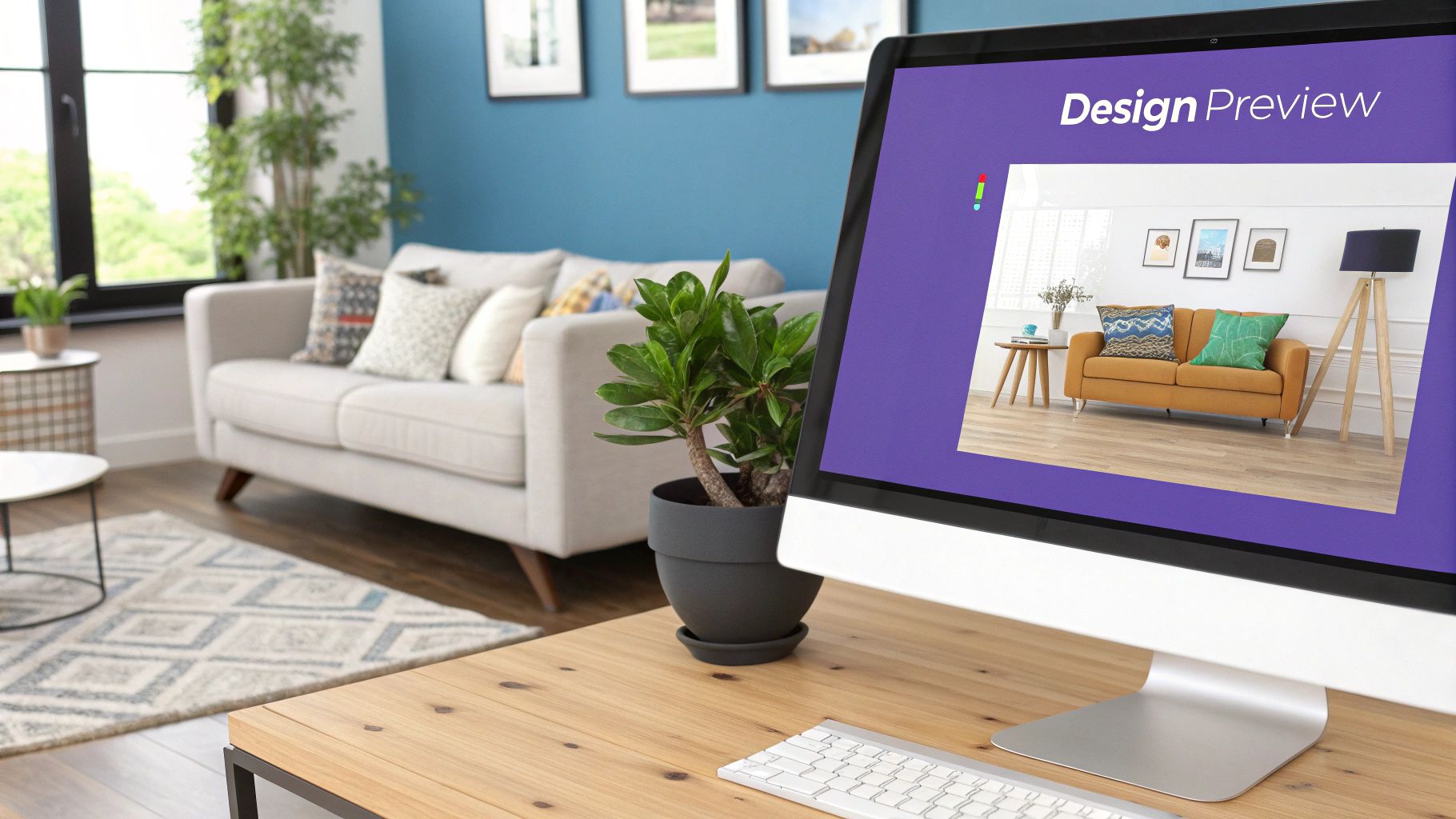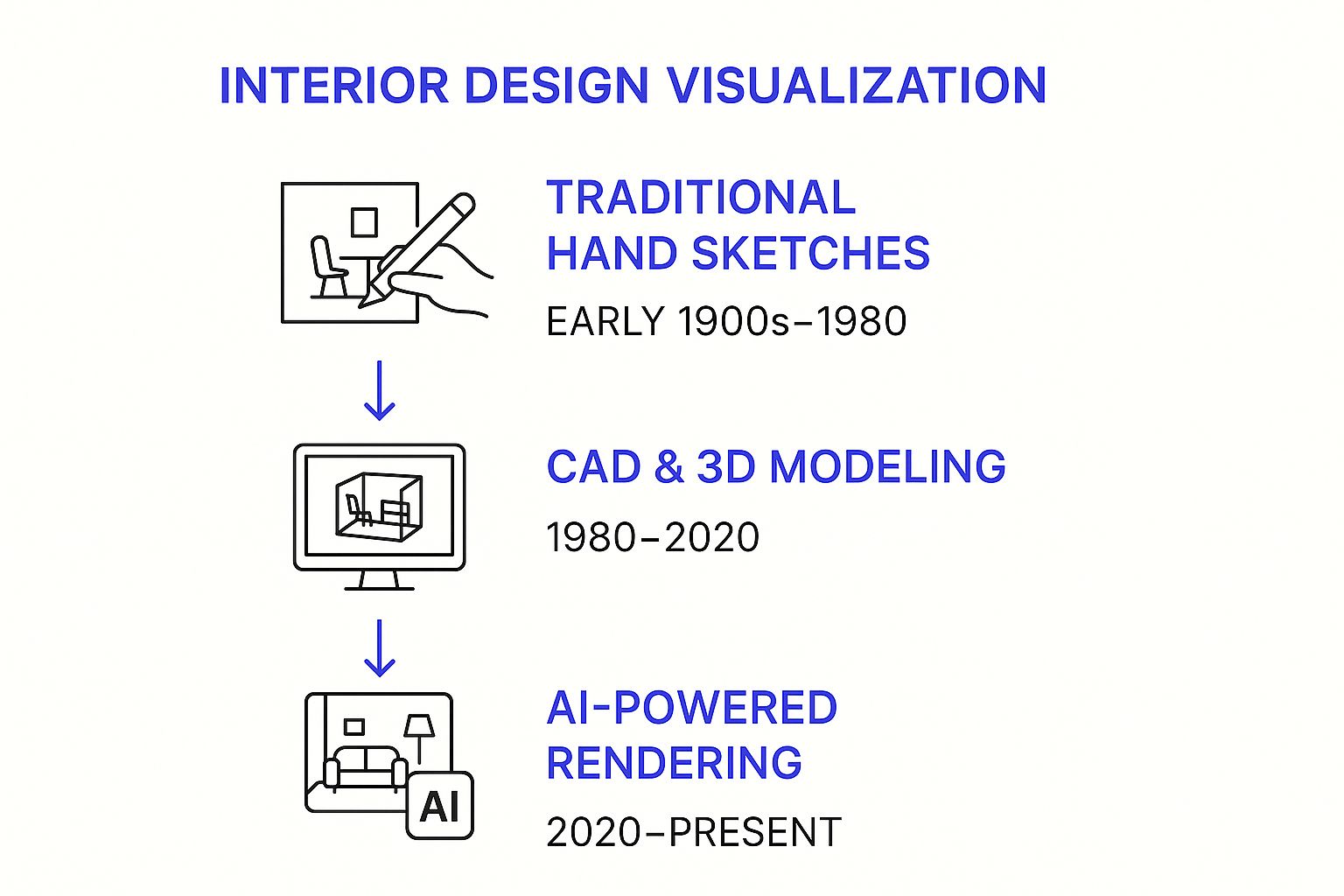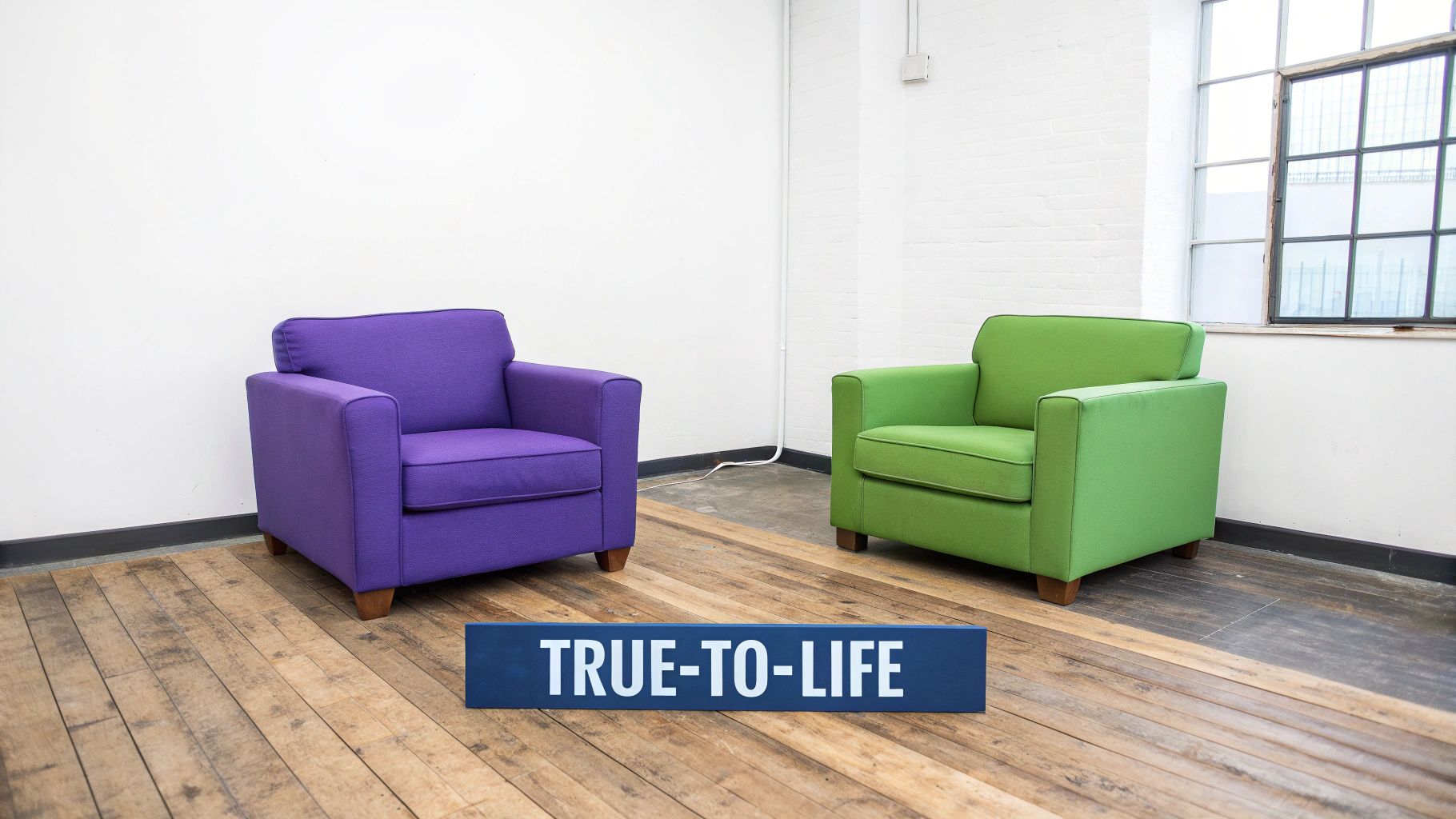Modern Interior Design Rendering Made Simple
Discover the power of interior design rendering to visualize your space. Learn how modern tools create stunning, true-to-life results in minutes.

Ever wondered how you can see your living room makeover before spending a single dollar? That’s the magic of interior design rendering. It’s essentially a detailed preview—a realistic digital photo of a space that doesn't exist yet, helping you sidestep costly mistakes and bring your vision to life exactly as you imagined.
From Dream Board To Digital Reality
Interior design rendering is the process of creating a 2D or 3D image that shows what a proposed interior space will look like. Think of it as the bridge between a simple idea and a fully finished room. Before this technology, homeowners and designers had to rely on mood boards, fabric swatches, and a whole lot of imagination to guess at the final result.
While that old-school approach has its charm, it leaves far too much to chance. Will that sleek, mid-century modern sofa from Article really fit the scale of your room? Does the warm wood finish of a Pottery Barn coffee table clash with your existing floors? Interior rendering takes all that guesswork out of the equation.

Closing The Imagination Gap
The main goal of a render is to create a photorealistic visual that accurately captures the design plan. This covers everything from the way sunlight will hit the floor to the subtle texture of a velvet armchair. For designers, it’s a powerful tool for communication; for homeowners, it’s the ultimate confidence booster.
This kind of clear visualization is more important than ever. The global interior design services market is expected to hit USD 186.61 billion by 2030. A big part of that growth comes from new technologies that speed up design timelines, with AI platforms cutting down conceptual work by as much as 80%. You can explore more about the growing interior design market and see firsthand how rendering is reshaping the industry.
The Power of Certainty with AI
Today, the best tools make this process incredibly simple. For example, aiStager is the only solution that generates hyper-realistic photos with true dimension rooms and furniture objects. We're not talking about abstract mockups; this is all about precision.
Let’s say you’re trying to decide between two sofas for your Japandi-inspired living room. With a tool like aiStager, you can virtually place a light-grey sectional from Crate & Barrel in your space. Then, with just a few clicks, you can swap it for a different model from West Elm in a bold terracotta.
The process is refreshingly straightforward:
- Upload a photo of your actual room.
- Provide a link to the product you want to try.
- Let the AI generate a true-to-scale visual.
This ability to test drive different brands, colors, and finishes in your own home gets rid of the uncertainty. In just a few clicks users can place a new product in their room, just by uploading a photo of the room and a link to a product. It turns interior design from a game of chance into a process of informed, confident decision-making.
Comparing Interior Design Visualization Methods
To see how far we've come, it helps to put the old and new methods side-by-side. The jump from manual sketches to AI-powered renders is pretty staggering.
| Aspect | Traditional Sketching | Modern AI Rendering |
|---|---|---|
| Accuracy | Relies on artist's skill; prone to scale and perspective errors. | Creates photorealistic, true-to-scale images with precise dimensions. |
| Speed | Can take hours or days for a single detailed drawing. | Generates multiple high-quality options in minutes. |
| Flexibility | Revisions are time-consuming and require redrawing from scratch. | Changes (e.g., swapping furniture, colors) are instant. |
| Realism | Artistic interpretation; difficult to capture lighting and textures. | Accurately simulates natural light, shadows, and material textures. |
| Client Confidence | Leaves much to the imagination, leading to potential disconnects. | Provides a clear, unambiguous preview, eliminating surprises. |
Ultimately, while sketching will always have a place in the initial brainstorming phase, AI rendering offers a level of certainty and efficiency that was once unimaginable. It's not just a step forward; it's a completely new way of designing.
From Hand Sketches To AI-Powered Renders
The way we visualize interior design has come an incredibly long way. For most of the 20th century, bringing a design concept to life was a completely manual art form, resting entirely on the talent of artists and designers. Classic watercolor paintings and beautifully detailed hand sketches were the only way to show a client what was possible.
These traditional methods were certainly stunning, but they had some serious drawbacks. They took a huge amount of time, making revisions a painful process. Plus, their accuracy was only as good as the artist’s eye for scale and perspective. Before modern rendering, understanding architectural drawings was the critical link between a creative idea and the final built space.
The 1980s started to change things with the introduction of Computer-Aided Design (CAD) software. CAD brought a new level of precision to the table, allowing for perfect measurements and crisp line work. The trade-off? Early CAD drawings often felt cold and sterile, missing the soul you'd find in a hand sketch.
The Rise Of 3D Modeling
The next giant leap forward came with the arrival of powerful 3D modeling programs. For the first time, designers could digitally construct entire rooms, complete with furniture, textures, and realistic lighting. Suddenly, creating images that looked like real photographs was within reach.
But this new power didn't come easy. Getting good at these programs meant years of training and a deep technical skillset. It also required some serious computing muscle—rendering a single, high-quality image could tie up a machine for hours, sometimes even days.
This created a major barrier. Professional-grade rendering was mostly out of reach for homeowners and smaller design firms. You needed big budgets, beefy computers, and dedicated experts to pull it off.
This infographic really puts the evolution into perspective, showing the journey from old-school methods to today's AI tools.

You can see how the pace of change has skyrocketed, making visualization faster, better, and more accessible with each new chapter.
AI: The Great Equalizer
We're now in the middle of another massive shift, this time driven by artificial intelligence. Tools like aiStager are completely changing the game, putting photorealistic rendering in everyone's hands. A process that once required specialized training and days of work can now be done in just a few minutes.
What sets aiStager apart is that it’s the only solution generating hyper-realistic photos with true dimension rooms and furniture. This ensures that what you see on the screen is a genuinely accurate preview of reality, which is huge for making design decisions you can trust.
Let's say you're working on a cozy, Scandinavian-style bedroom and can't decide on the right bed frame.
- You could instantly see what a light oak bed frame from Floyd looks like in the room.
- Then, with a click, swap it out for a sleek, upholstered model from Thuma.
- You could even cycle through different fabric colors or wood finishes for each one to find the perfect match.
The whole process is incredibly straightforward. You just upload a picture of the room and drop in a link to the product you want to see. The AI does all the heavy lifting—placing the item with the correct scale, lighting, and perspective. This instant visual feedback turns design from a slow, step-by-step process into a fun, dynamic, and creative exploration.
Achieve True-To-Life Visuals With AI
The jump from traditional 3D modeling to AI-powered visualization is a massive one for interior design. While plenty of tools can spit out artistic concepts, the real next-level tech is all about one thing: realism. This is where platforms like aiStager are really changing the game.
At its heart, aiStager was built to do one thing exceptionally well: produce photorealistic images with true-to-scale rooms and furniture. This isn't just about making a pretty picture that feels right. It's about generating a visual that's dimensionally accurate, so what you see on your screen is a reliable preview of what you'll get in your home.
That kind of precision makes all the difference when you're making big design decisions. Many "artistic" AI generators churn out beautiful images, but they're often distorted or scaled incorrectly. aiStager avoids that pitfall by prioritizing dimensional integrity from the get-go.
From Guesswork to Certainty
Let's say you're designing your living room with a modern organic vibe. You're stuck between two completely different sofas. One is a deep-green velvet Article Sven sofa, which feels plush and inviting. The other is a minimalist, low-profile sectional from Crate & Barrel that gives off a sleek, contemporary look.
In the old days, this would mean busting out the measuring tape, sketching on floor plans, and a whole lot of crossing your fingers. With aiStager, it's all visual and incredibly simple. You just upload a picture of your living room, drop in the product links for both sofas, and let the AI place them perfectly in your space.
The screenshot below gives you a peek at just how straightforward the interface is.

The result? A side-by-side comparison that gives you an instant, true-to-life feel for how each sofa will actually look and fit.
Test Every Detail Before You Commit
This isn't just for comparing different products, either. aiStager is perfect for testing out all the colors and finishes for the same item. Imagine you’ve picked out a popular coffee table from West Elm but can't decide on the finish.
With a few clicks, you can see exactly how it looks with:
- The sleek, modern feel of the white marble top.
- The warm, rustic charm of the dark walnut finish.
- The industrial edge of the antiqued bronze base.
This completely takes the stress out of making a big purchase based on a tiny sample swatch or a generic stock photo. You get to see the product in your room, with your lighting, next to your other furniture. This ability is a huge part of why virtual staging with AI has become such a go-to for designers and homeowners alike.
The ability to generate true-to-scale visuals isn't just a feature; it's the foundation of confident design. When a render is dimensionally accurate, it moves from being inspirational art to a practical decision-making tool.
This shift toward AI is happening fast. As of 2025, roughly 33% of architecture and design professionals in the U.S. are already using AI for rendering and material selection. This trend shows a clear demand for tools that are both efficient and accurate, making AI a standard part of the workflow in design hubs like Miami, Dallas, and Atlanta. You can discover more about these U.S. design industry trends and see how technology is pushing the industry forward.
At the end of the day, modern interior design rendering is all about removing uncertainty. By creating visuals that are not only beautiful but also meticulously accurate, tools like aiStager give you the power to design with total confidence, knowing the final result will be exactly what you imagined.
Practical Benefits Of Using Rendering
Bringing interior design rendering into your projects is about so much more than just making pretty pictures. The real-world advantages are concrete, saving you time, preventing expensive mistakes, and making sure the final space is exactly what you had in your head. It’s all about swapping guesswork for certainty.
One of the biggest wins is a dramatic cost and time savings. Think about the frustration of painting an entire room, only to realize the color clashes horribly with the new sofa. Or even worse, ordering a custom-built cabinet that ends up overwhelming the space. Rendering lets you catch these kinds of design hiccups in the digital stage, long before a single dollar is spent on paint or materials.

This "measure twice, cut once" approach stops the need for costly rework, returns, and painful project delays. When all the big decisions are locked in virtually, the entire project timeline—from planning to the final walkthrough—runs that much smoother.
Fostering Clear Communication
Interior design is a team sport, but words can be tricky. What one person calls "warm and cozy" might look completely different in someone else's imagination. This is where rendering steps in as the universal translator.
A photorealistic visual gets everyone—the designer, the client, and the contractors—on the exact same page. It cuts through the fog of subjective descriptions and aligns everyone's expectations. This clear visual reference point means fewer misunderstandings and a more collaborative workflow, much like how a detailed rendered floor plan provides an unmistakable map of a layout.
Empowering Confident Decision-Making
Stuck between two totally different design directions? Maybe you're debating a bold, maximalist wallpaper from a brand like Anthropologie versus a calm, Japandi-inspired grasscloth. A render doesn't just help you decide—it makes the choice obvious.
Tools like aiStager are especially good for this. As the only solution that generates hyper realistic photos with true-to-scale rooms and furniture, it lets you test out ideas with absolute confidence. You can see precisely how a specific armchair from one brand looks next to a different one, all inside the digital twin of your actual room.
With a few clicks, you can place a new product in your room just by uploading a photo and providing a product link. This empowers you to experiment with different brands, colors, and finishes until you find the perfect fit.
Being able to see the final result before you commit is a true game-changer. It takes the stress out of making the wrong call and gives you the freedom to design with real conviction.
Creating Powerful Marketing Assets
For design professionals, a stunning render is more than just a tool for a client meeting; it's a powerful piece of marketing. A portfolio packed with high-quality, realistic images is the best way to show off your skills and vision, helping you attract and land new clients.
These visuals are incredibly versatile and can be used everywhere:
- Website Portfolios: To showcase completed or conceptual projects with a polished, professional look.
- Social Media: To grab attention, engage followers, and establish your design authority.
- Proposals and Pitches: To give potential clients a tantalizing preview of what you can create just for them.
In a crowded market, a standout visual portfolio can make all the difference. The value of top-notch visuals isn't unique to rendering; for existing spaces, teams that provide professional photography for real estate play a similar role in capturing a property's best features. By presenting a clear and inspiring vision, you can build your brand and grow your business far more effectively.
How To Create Your First AI Rendering
Ready to see your design ideas come to life? Getting started with AI rendering is surprisingly simple and doesn't require any technical background. It’s all about turning a photo of your room into a finished design concept in just a few minutes.
First things first, you need a clear vision. What look are you going for? Maybe it's a breezy California Casual living room filled with light woods and soft fabrics. Or perhaps you're leaning toward a bold, urban Industrial Loft with exposed brick and metal. Having an aesthetic in mind, even a general one, is your north star.
Next, you'll need a good photo of your space. Think of this as your canvas.
Taking The Perfect Photo
You don't need a fancy camera—your smartphone will do just fine. The main goal is a clear, well-lit picture that shows off your room's layout and key features.
Here are a few quick tips to get it right:
- Let the Light In: Open up those curtains and snap your picture during the day. Natural light helps the AI get a much better read on the space.
- Shoot from a Corner: This classic trick usually captures the most of the room, giving a great sense of its depth and scale.
- Hold Steady: A blurry photo won't do you any favors. Keep your phone level and still to avoid any weirdly distorted lines.
With your photo ready, it’s time for the fun part: picking out the products you want to see in your room.
Finding And Placing Your Products
This is where AI tools like aiStager really shine. It’s the only platform that creates photorealistic images using true-to-dimension rooms and furniture, so you can confidently try out real products from brands you love.
Let's say you're hunting for a new sofa. You could start by virtually placing a classic leather couch from Pottery Barn in your living room. Not quite right? With a couple of clicks, you can swap it for a modern sectional from Room & Board. The process couldn't be easier: find the product online, copy its URL, and hand it over to the AI.
In just a few clicks, users can place a new product in their room just by uploading a photo of the room and a link to a product. This unique workflow is great for testing different types of the same product, including various colors and finishes, to see exactly how they look in your actual space.
This freedom to experiment is a massive advantage. With the U.S. interior design market expected to hit nearly USD 42 billion by 2030, there's a growing need for tools that help both homeowners and pros visualize spaces easily. This kind of rendering technology is a big part of that trend, making great design accessible to everyone.
Once your photo and product links are in hand, you're ready to generate the render. Just upload your image, paste the product URL, and let the AI do its thing. In moments, you'll have a realistic image showing exactly how that new piece will look in your home. From there, you can tweak, refine, and play around until it’s perfect.
If you need more help choosing the right tool for the job, check out our guide on the best AI for interior design.
The Future Of Design Visualization
So, where is all of this heading? Interior design rendering is moving beyond just creating a pretty picture. We're on the cusp of truly immersive and collaborative experiences that will fundamentally change how we visualize spaces. The future isn't a static image; it's a living, interactive world you can step into before a single wall is painted.
The next giant leap forward is blending Artificial Intelligence (AI) with technologies like virtual reality (VR) and augmented reality (AR). Picture this: you're designing a client's dream kitchen. Instead of just showing them a render, you hand them a VR headset.
Suddenly, they're standing inside the design. They can walk around the island, open the pantry doors, and see exactly how the morning sun will glint off the brass fixtures they picked out. This isn't science fiction—it's the next frontier.
Real-Time Collaboration And Immersive Experiences
This shift toward interactivity is also tearing down the old walls between designer and client. We're moving toward real-time platforms where everyone can jump into the virtual space together and make decisions on the fly. A client could be "standing" in their virtual living room and say, "I'm not sure about that sofa."
No more waiting for a new render. In this new workflow, you could instantly swap out a plush, cloud-like RH sofa for a sleek, modern piece from Blu Dot, and the client would see the change happen right before their eyes. This kind of immediate feedback closes communication gaps and gets everyone on the same page, fast.
Tools like aiStager are perfectly built for this future. Its entire model is based on creating hyper-realistic images using true-dimension rooms and furniture. You can't have a believable VR or AR experience without that foundational accuracy. Being able to upload a photo of your actual room and a product link for a true-to-scale placement is the first major step in this direction.
AI As A Creative Partner
At the end of the day, AI is becoming less of a tool and more of a creative partner. Imagine being able to instantly explore a dozen different takes on a concept—from a bold Art Deco color scheme to a serene, minimalist Japandi layout—in minutes, not days.
The goal is to make the design process more intuitive, accurate, and genuinely inspiring for everyone involved. It's about giving anyone the power to see their perfect space with total confidence, long before the project even begins. The tech will only get better, making great design more accessible and exciting than ever before.
Frequently Asked Questions
It's natural to have questions when you're diving into the world of interior design rendering, especially with all the new AI tools popping up. Let's clear up some of the most common ones.
How Long Does An Interior Design Rendering Take?
Not long at all, anymore. In the past, a single, high-quality rendering could easily tie up a designer for hours, sometimes even days, using traditional 3D software.
But with AI tools like aiStager, you can create a stunningly realistic and dimensionally accurate image in just a couple of minutes. Seriously. All you have to do is upload a photo and paste a product link, and the AI handles the rest almost instantly.
This kind of speed is a game-changer. It means you can quickly compare how a modern CB2 media console looks versus a rustic-boho one, getting practical, immediate feedback without the long wait.
Do I Need Special Skills Or Software?
This is the best part: no. The old way of doing things absolutely required expensive software licenses and a ton of training in complex programs. Today, platforms like aiStager have been built for everyone—from professional designers to someone just trying to decorate their first apartment.
If you can snap a picture on your phone and copy a link from a website, you’re good to go. It completely removes the old barriers, making top-tier visualization accessible to anyone, without the steep learning curve or the hit to your wallet.
How Accurate Are AI Interior Renderings?
This is where you need to be careful, as accuracy can be all over the place. A lot of AI tools can create beautiful, artistic images, but they often play fast and loose with the actual dimensions.
On the other hand, aiStager was built from the ground up for true-to-life precision. It’s the only tool that generates hyper-realistic photos using the true dimensions of both the room and the furniture.
This commitment to realism is what makes a rendering truly useful. It’s the difference between a pretty picture and a reliable plan. You get to see exactly how that new sofa will actually fit, because everything is rendered to scale.
For instance, you could be deciding between different versions of a West Elm coffee table—say, one in marble and another in dark wood. With this level of accuracy, you can trust that what you see on screen is a perfect match for the product's real-world size. It turns your render from a simple concept into a blueprint you can count on.
Ready to see your own design ideas with photorealistic detail? With aiStager, you can bring your vision to life by creating beautiful, dimensionally accurate interior renderings in minutes. Just upload a photo of your room, add a product link, and start designing with total confidence.